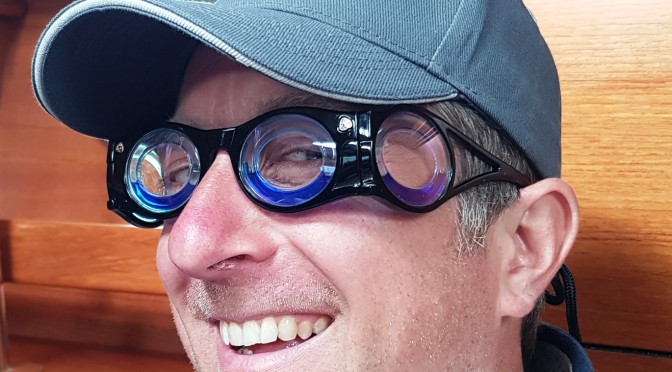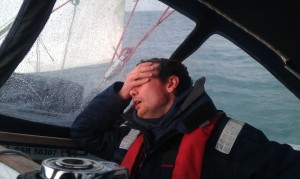
If you are one of the few that have never felt sea sick when afloat – you are blessed. Figures suggest that just 1 in 10 people are not susceptible… the rest of us can get ill and do so from time to time.
However, all is not lost – it can be controlled. Don’t get frightened by the thought of it and never go afloat. We understand that there can be a fear of getting this type of motion sickness and that if you have already experienced it – you will never want to experience it again. Read on for more information.
I was recently in a First Aid refresher and the lecturer said, ‘I just wish more people would take the drugs available!’
You would be amazed at how many people believe that they will be immune to it. Our Skippers and First Mates take the drugs at the level they know will keep them okay relative to the predicted sea state and wave patterns.
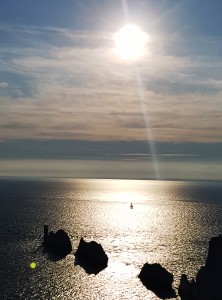
For some reason a lot of people take a previous ‘benign’ experience afloat as the bench mark for their trip on a yacht. If previously, they have only sailed among Islands and have often been sheltered on the lee side they may not have been exposed to the fetch (the distance travelled by wind or waves across open water) of an open sea and the waves it produces. Think logically about your previous experiences and what you have been exposed to. It is only with an increased amount of experience that you understand what each sea is capable of and what type of motion you may experience.
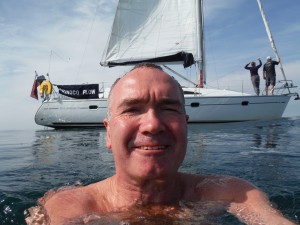
We sail in the Solent, the English Channel, around France and the Channel Islands, Canaries and also in the Mediterranean. All produce different types of seas in a variety of wind conditions. We would generally be able to tell you what to expect. See here a mid Channel swim in September!
Solent Sailing
When sailing within the Solent we do not experience rough seas however on occasions with strong wind against a spring tide in the deeper water we can get small steep waves which the majority of people find exciting with no ill effect. If need be, with less tide in the shallows, we can search out flatter water and always find shelter in Newtown Creek or the Beaulieu River if people need a little respite. Going downwind with the tide gives flat water so often if you have gone west to Yarmouth or Lymington one day and it was a little bumpy – it will be flat as a pancake when you go back East the following day.
Also different boats will create a different motion. On a smaller yacht you ‘bob’ about a bit more – on a larger yacht or a different hull shape you can have a different motion. We use 37-44ft yachts in UK waters and often 50ft plus abroad. The larger yachts cope with bigger winds and bigger seas.
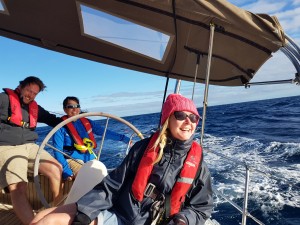
In the Canaries, on the west sides of the Islands in deep water, with normal prevailing conditions there is a ground swell which produces a long wave which even when large are not uncomfortable. These steepen up once the water shallows – and we mean deep 3,000m and shallow 300m or less. The wind on top of this ground swell can create it own steeper waves. On the East & South side (generally the sheltered side) of the Islands you get a mixture ranging from smooth to rough depending upon the wind at the time.
Speak to the Skipper about what to expect of your time afloat – it will depend where you are and ask him / her what to do about potential sea sickness.
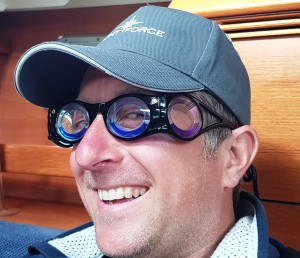
This is an excerpt from the joining instructions that we send to people when they come on one of our cruises… we go in to some detail because so many people discount the possibility of getting sick due to the motion on board.
”Sea Sickness: Apparently the stats show that only 1 in 10 people do not get sick. The rest of us control it as best we can…We want you to enjoy your trip. Remember that a channel crossing of just 14-17 hrs is tiring and if there is any sea sickness aboard it is absolutely exhausting for that person and can put additional pressure upon the crew who are left operational. All crew need to take their medication to prevent sea sickness – and in good time. Check the prescribed doses but sometimes a tablet the night before helps get the drug into the system is a good tip. Sea sickness can be controlled – so use the drugs, patches, pressure points If you cannot take the tablets try the patches behind the ear linked in the article – Scopoderm TSS.
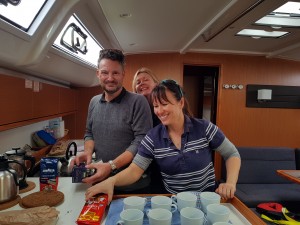
It is important that everybody should be able to go below and make tea and knock up a sandwich, fill the log, do some nav, go to the loo! It isn’t just the Skippers job to go below all the time – it is a shared responsibility. ‘I don’t get sick’ people say – however, they then do not feel well enough to go below. If that is the case, then you do suffer from sea sickness, and you need to take measures to control it.
There is also the problem that someone becoming ill puts additional strain on the rest of the crew because they cannot fulfill their responsibilities.
Be rested before a trip.
Be hydrated.
Stay warm.
If safe ‘heave to’ when people need to go to the loo and even on watch changes giving people the opportunity to get dressed quickly in a stable environment etc, keep the boat on a straight course and do not be hung-over before a passage! Then you can function to the best of your abilities… that it would seem, is only fair to all on the boat. Do your best that is all that is expected of you.”
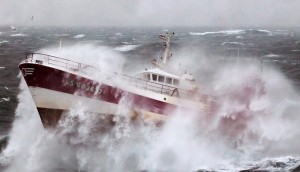 Met Office Definition of Sea State
Met Office Definition of Sea State
It may be that people have not experienced a rough or confused sea. And what they consider a rough sea is in fact only moderate or even slight by definition. Remember that if you have wind against tide it will shorten the wave making it steep – and when the tide turns it will reduce the sea conditions somewhat.
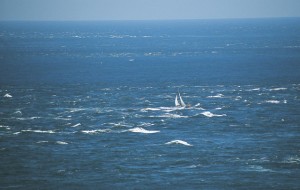 Overfalls will create a confused sea and even if only slight, the confused motion may trigger sea sickness or make people feel unwell so if safe to do so, it may be wise to be in the cockpit. Tucking under a headland or in the lee of the land will flatten the sea state and miraculously make people feel better. Often on the passage to St Vaast in a westerly wind any people feeling ill suddenly feel better as soon as we are in the lee of the Cherbourg peninsular. Heaving to can also help.
Overfalls will create a confused sea and even if only slight, the confused motion may trigger sea sickness or make people feel unwell so if safe to do so, it may be wise to be in the cockpit. Tucking under a headland or in the lee of the land will flatten the sea state and miraculously make people feel better. Often on the passage to St Vaast in a westerly wind any people feeling ill suddenly feel better as soon as we are in the lee of the Cherbourg peninsular. Heaving to can also help.
Wave Height Definitions:
Smooth Wave height less than 0.5 m
Slight Wave height of 0.5 to 1.25 m
Moderate Wave height of 1.25 to 2.5 m
Rough Wave height of 2.5 to 4.0 m
Very rough Wave height of 4.0 to 6.0 m
High Wave height of 6.0 to 9.0 m
Very high Wave height of 9.0 to 14.0 m
Phenomenal Wave height more than 14.0 m
Measurements are from trough to peak. You can expect some waves to be larger and you may get 14% of waves – 1 in 7 waves – to be bigger and 3 an hour to be larger than those.
Met Office
The Met Office gives forecasts and gains its data from various sources of actual height around the UK coast – it uses tethered buoys and also takes reports from ships reporting in with met data. I have rung in for a forecast and been told that a ship has just passed a certain point and given heights of ‘so an so’ – and that has influenced my decision to set sail or not.
The Met Office’s network of Marine Automatic Weather Stations (MAWS) consists of 11 moored buoys and seven systems on lightships and islands. Three of the buoys are in coastal inshore waters, six are in open-ocean locations to the west of the British Isles and two, jointly owned with the French, are in the deep waters off the Bay of Biscay. These are supplemented by six moored buoys operated by Ireland and one by the Jersey Met Department.
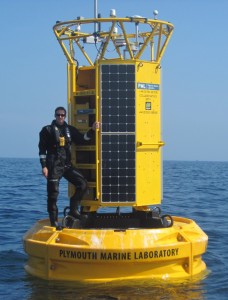 Moored Buoys
Moored Buoys
Out of the water each buoy stands 6 m tall, measures 3 m in diameter, weighs 4.5 tonnes and has anchor cables several kilometres in length to moor it in the deep ocean off the continental shelf. It is deployed by a ship with heavy lifting gear and operates for up to two years between service visits. It measures air pressure; air temperature; sea temperature; humidity; wind speed, wind direction, wave height and wave period.
Prevention of Sea Sickness
Take Medication
(Different anti-sea sickness drugs may help – so try others)
Use the Ear Patches
Use Pressure Bands
Get Fresh Air
Helm
Don’t Read
Don’t Stay Below (initially)
Avoid Some Smells (Fatty Cooking / Diesel / Hot Engines)
Stay Warm
Stay Hydrated
Stay Fed
Ginger Biscuits
Ginger Tea with honey
Gin Gins (sweets)
Do Not Be Hung Over
Wear the Goggles (Boarding Ring Glasses)
Put People to Bed
Avoid Others Vomit
Stand on land
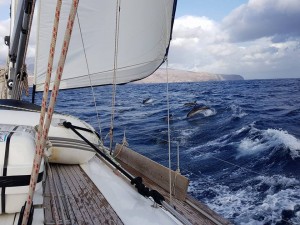
All or some of these things may help. Obviously with short passages it will pass quickly as we get onto land however those passage making do not have the luxury of getting off!
Finally, don’t be put off.
Try other things. We have had people that are unable to be a passenger in a car without being ill who have spent a week aboard with no effect whatsoever. They wore the ear patches and were fine down below regardless of the weather!
Fancy signing up for a trip? Check out this page with dates at the bottom…

